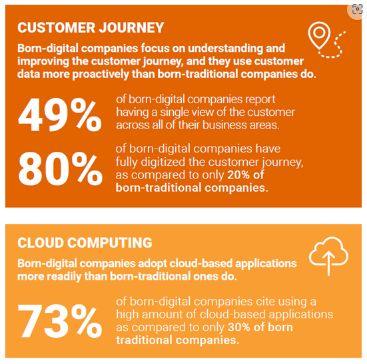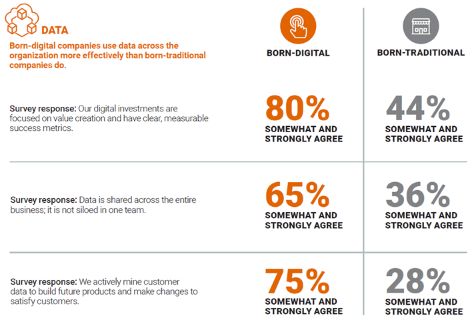What born-traditional companies can learn from their born-digital counterparts
To compete against digitally savvy businesses,born-traditional companies built on Industrial Ageprinciples and practices will have to make big changes.It won't be easy, but taking a page from digitalexemplars' success playbook will help.
This article is part of our Born-Digital study, where AlixPartners set out to research born-digital companies' unique blend of strengths and challenges and identify the most pressing needs and areas of focus needed to sustain their success.
Everyone knows that born-digital companies are growing at a blistering pace compared with their born-traditional counterparts.
Born-digital businesses are both the protagonists and the disruptors in a diverse array of industries—andthey're making life simpler for customers by providing meticulously personalized offerings, delivering goods and services at unprecedentedspeeds, and presenting customized options like delivering to your door versus delivering you to their door.
For born-traditional companies, competing against their born-digital counterparts is no easy feat, and many are at risk of being displaced. In our experience, many born-traditional businesses have dragged their feet inresponding not only to the threats posed by born-digital successes but also to the new opportunities these fast growing newcomers present.
Specifically, born-traditional firms have a valuable chance to learn from their digitally savvy counterparts on multiple fronts—like how to extract maximum business value from data, how to tailor their offerings to a customer's every need, how to empower their employees to innovate, howto use digital technologies such as cloud computing, and how to rethink their organizational structures.
Indeed, findings from our recent survey show that born-traditional companies have lagged behind their born-digital counterparts in several respects, including how far along they are in digital transformation, where they focus their digital efforts, and how they use analytics.
Most of the born-digital companies in our study consider themselves digitally mature, whereas most of the born-traditional companies are still transforming
- 9% of born-traditional companies are digitally transformed
- 73% of born-digital companies are digitally transformed
Understanding what's behind born-digital nimbleness and speed
Why are born-digital companies so much more nimble than born-traditionalones, and how do they manage to grow so quickly? Inpart, it's because born-digital enterprises have less to lose than theirborn-traditional counterparts do. That is, they don't have to destroysomething to create something else. That's why they can more easilymove quickly and with less disruption.
For born-traditional companies willing to initiate major change, walkingaway from the winning formula that got them where they are today isdifficult. Closing stores, shutting down factories, outsourcing functions,using analytics in new ways to get insights on pricing and promotionstrategy—all such moves require painful choices and a willingness todestroy old ways of doing business. That's especially upsetting andfrightening for the people who created those old ways of doing things.

Embracing an innovation mindset—giving up management control
In taking a page from their born-digital counterparts' playbook, born-traditional companies will have to make two especially daunting changes. First, they'll have to adopt a new mindset—one characterized by rapid prototyping and experimentation. And second, they'll have to let go of the centralized control and process management approach they've long used.
Industrial Era principles and practices have been honed across many decades—from the eighteenth century to today. Its defining characteristics include the achievement of economies of scale, the establishment of repeatable and predictable physical processes, and the use of centralized and hierarchical decision making. Some of the elements of that approach are still needed today to support operational efficiency—and born-digital companies can benefit from mastering them, too. But when it comes to the innovation and growth that born-digital businesses excel at, other elements of the Industrial Era approach have become increasingly out-of-date—and even harmful for traditional, born-traditional companies.
Modifying a born-traditional approach to business will require courage on the part of these companies. Understanding the journey one company followed demonstrates that it can be done.

To up their digital game, born-traditional companies will have to make major changes on multiple fronts—including their business and operating models, their organizational cultures, and their talent management approaches.
Companies that tackle those tasks now will stand the best chance of surviving the disruption that born-digital enterprises have introduced into the business environment.
Leaders' takeaways
- Be open (1) to adopting new business and operating models that help you get greater value from data and (2) to designing new organizational structures that boost your digital prowess—such as integrating your IT organization more tightly with the business.
- Foster an agile, innovative culture to accelerate your product development processes—for instance, by establishing collaborative relationships with external partners versus viewing them through an us-versus-them lens.
- Craft strategies for managing the staff turnover that will inevitably result from making the changes needed to up your digital game such as stipulating new skill requirements, setting forth new job definitions, starting to use new technologies, shifting from command-and-control to employee empowerment, and creating new organizational structures.
Download the full PDF, here
The content of this article is intended to provide a general guide to the subject matter. Specialist advice should be sought about your specific circumstances.





